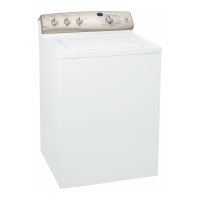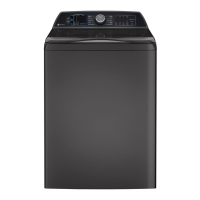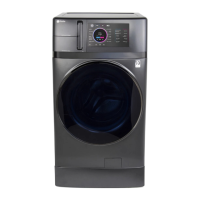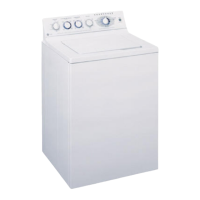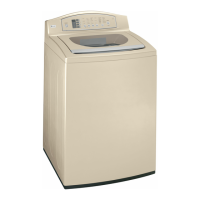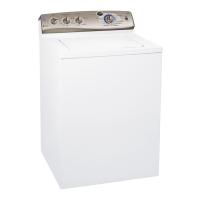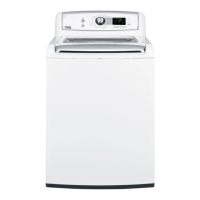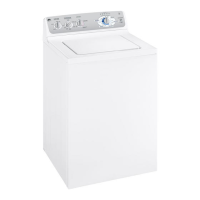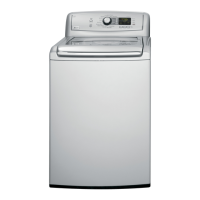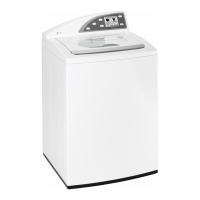
Do you have a question about the GE Profile Harmony WPGT9360 and is the answer not in the manual?
| Brand | GE Profile |
|---|---|
| Model | WPGT9360 |
| Type | Top Load Washer |
| Color | White |
| Energy Star Certified | Yes |
| Weight | 205 lbs |
| Steam Function | Yes |
| Smart Capable | No |
| Wi-Fi Enabled | No |
Information for individuals with electrical, electronic, and mechanical experience.
Mandatory steps for safe servicing, including grounding and power disconnection.
Explains the meaning of characters in the GE washer model number.
How to determine the manufacture date from the serial number format.
Outlines warranty periods, what is replaced, and associated costs.
Lists items not covered and consumer legal rights under the warranty.
Highlights the Harmony Washer's advanced washing technology and features.
Explains the operation and purpose of each control panel button and the touch screen.
Step-by-step guide for loading, detergent use, cycle selection, and starting.
Guidance on choosing cycles based on color, garment type, or fabric type.
Description of special cycles for specific items or cleaning needs.
Instructions for using the Stain Inspector to treat specific stains.
How to modify soil level, temperature, and wash action via the summary screen.
Details on using wash options like Delay Start, Presoak, and adjusting cycle time.
Steps to create, save, and recall personalized wash cycles.
Using the HELP button for information and troubleshooting common problems.
Configuring button beep, end-of-cycle signal, and washer/dryer communication.
Explains the wash process, load sensing, and water fill mechanisms.
Details on basket rotation for washing and temperature regulation.
Describes the washing, spinning, and rinsing phases of the cycle.
Diagrams identifying key components visible from the top of the washer.
Details the pin configurations for the inverter and main control boards.
Steps for removing the backsplash and the main control board assembly.
Instructions for accessing the membrane keypanel and inverter board.
Procedures for testing inverter power supply and output voltages.
Steps for removing the protective cover and servicing the brake resistor.
Explains the sensor's role in water level detection and how to test it.
Details the water valve's solenoids, resistance, and removal procedure.
Instructions for removing the top cover and associated wiring.
Procedure for removing the wash basket, infusor, and hub nut.
Guide to cleaning the impeller and removing the drain pump assembly.
Explains how the thermistor regulates wash water temperature.
Detailed steps for safely removing the heavy outer tub assembly.
Describes the heating element's role and the hi-limit thermostat's safety function.
Steps for removing and installing the heating element and hi-limit thermostat.
Flowchart for diagnosing and resolving heating element problems.
Information on the direct-drive motor's construction, speed, and resistance.
Explains the Hall sensor's role in RPM measurement and testing procedures.
Describes how the clutch operates during different wash cycles.
Steps for diagnosing clutch motor voltage, resistance, and switch function.
Instructions for removing the bearing housing assembly.
Guide to accessing and navigating the field service mode for diagnostics.
How to read error codes and diagnostic messages in service mode.
How to access and perform factory tests on washer components.
Diagram illustrating transitions between different washer operating modes.
Diagnosing issues with the LCD display, touch screen, and buttons.
Troubleshooting motor noise and improper water shut-off.
Interpreting error codes for Flash ROM, Thermistor, and flood conditions.
Troubleshooting steps for drain system, fill issues, and pressure sensor errors.
Diagnosing problems with touchscreen, lid switch, and motor rotation.
Troubleshooting brake failures, inverter communication, and clutch issues.
Diagram illustrating the electrical layout and connections of washer components.
Visual guide to parts located on the washer's top panel and front.
Diagrams showing parts related to the washer's chassis and base.
Visual representation of internal parts including the drum, motor, and heating element.
Catalog listing part numbers, descriptions, and quantities for washer components.
Catalog listing part numbers, descriptions, and quantities for washer components.
Explains the purpose and steps for switching backsplashes, listing tools.
Steps to remove the washer control board and its backsplash assembly.
Steps to remove the dryer control board and its backsplash assembly.
Instructions for attaching control boards to new backsplashes and final reassembly.
